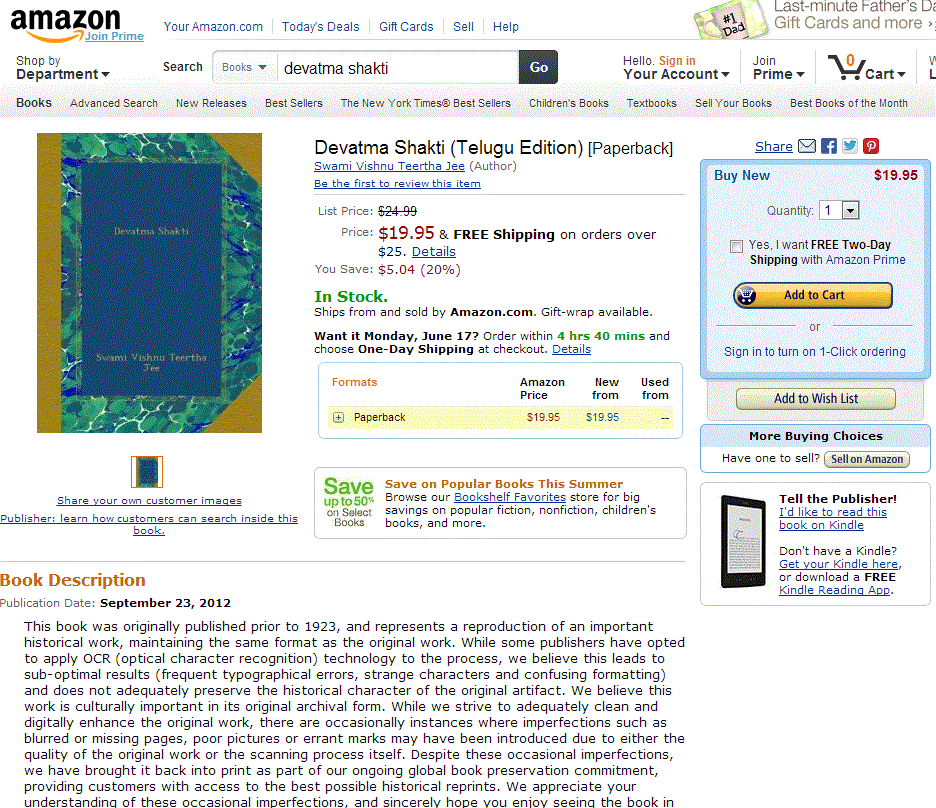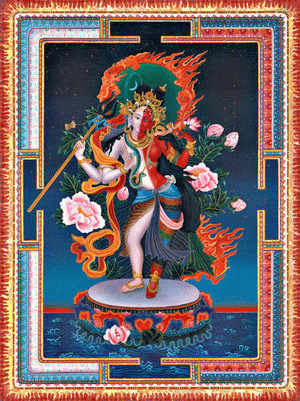Shakti (Kundalini) Divine Power. by Swami Vishnu Tirtha
Maharaj, with Forward by Mahamahopadhyaya Gopinath Kaviraj,
J.A., Formerly Principal, Government Sanksrit College,
Varanasi,1962
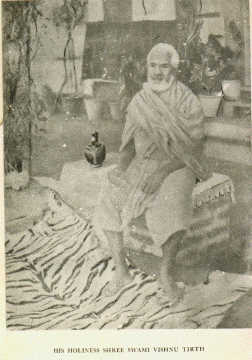
His
Holiness Shree Swami Vishnu
Tirtha

Chapter V.
Kundalini Power
‘As of all’ with hills, woods and
lands the support is the lord of Serpents, so of all the
treatises of Yoga the support verily is kundali.
(Kundalini)
It has been shown in the foregoing
pages that the Vedic Uchchishtha Brahman figures in the
Pauranic mythology as Sesha Serpent and is the Residual
Serpent power left over after the creation is complete and
the corresponding static adhyatma; is pictured as Narayana
resting on the Serpent. There sesha is described as
supporting the Cosmos. In individual living beings the
individualized Sesha left over after the physical body is
built up is described as Kundalini Serpent, which supports
the individual body, having Her Seat at Moolddhar
(Mool–root, Adhdr—support) the root or basic support of
the spinal cord known to the anatomist as coccygeal bone or
coccyx. The corresponding static adhydtma is
swayambhoolinga, self-born thallic-formed Shiva with the
kundalini serpent coiling around three and half times,
asleep with tail in her mouth placed at the top. What
aroused the Power uncoils and takes its march back to the
evolutionary side loosening the bondage. She ascends the
spinal nerve and displays higher visions during the march of
ascent. In cerebrum She comes into communion with Her Loral
and merges into the Static Real. At other times when She is
not in communion, She resides in the Vishuddha Chakra of the
Cervical region resplendent in Her purity. When awakened She
is experienced by Yogins as a spiritual guide who directs,
controls, governs and leads the aspirants on the spiritual
path to moksha like a living conscious divine help-mate,
with Her vigilant hand helping Her favourite all the
twenty-four hours in sleep, dreams and waking state, and at
times takes him up for the Saniddhic communion with Her
Lord. She then works character of a man and develop into
instinct. The particular actions and environments are soon
lost behind the vistas of past time and memory lets them
slip off its hold, but their influence on the mind lasts
tenaciously throughout the life and even transmigrates to
future births. Certain children are by nature shy, polite,
modest, truthful, peace-loving, merciful and possessed of
fine character whereas others are mischievous, cruel and
naughty. Certain part of their character might b due to
their training but mostly it would appear on exanplation
that they got those characteristics from birth, family
consequences having had little effect on them. Different
children of the same parents, brought up within the same
surroundings under similar influences show quite opposite
tendencies and inclinations. Character includes both good
and bad habits a person has imbibed.
When once a habit is formed it
requires a hard struggle to quit it; one has to undo the
whole lot of mischief that has been done on the mind by the
long process of repetition. Therefore we ought to be ever
watchful as to how a particular incident impresses us. If
our minds are proof against outer influences we have no fear
of contracting any habits. Particular incidents and
individual actions do not much count but it is the animus
and the motive that is to be taken care of, as they are
responsible for the formation of a man’s nature. A person’s
social, moral, intellectual and spiritual culture is thus
built by a gradual discipline of mind through long thinking
and by acting up to the ideal in his mode of
living.
Thus a mind free from attachment and
hatred, always deeply engrossed in high pursuits, not
minding the likes and dislikes of the objective world or ups
and downs of life, steers through his mission with brave,
fearless and undaunted heart, stands like a rock against the
waves of the seething ocean of life. He forms a ,character,
firm and bold, not affected by the society he moves in, but
moulding the latter after his own fashion. He works hard and
lives a busy life working miracles all his life, butt
himself remaining unaffected like a lotus leaf in water.
Such persons are called jiwanmuktas and are free from the
worldly bondages even in life, and after death shall be
absorbed into the universal, spirit no more to be reborn no
passively as when sleeping but as divine mother on all the
three planes of physical, astral and causal bodies. Her
movements are then felt, Her voice heard, and presence
experienced. She then becomes a Reality and not simply an
object of imagination and conjecture.
To a person of the modern education
every idea connected with spirituality conveys an impression
of something like nothing; if anything it is of a nature
paling into the realm of unreality and superstition. To
students of physic science, Metaphysics, every thought
pertaining to God and Powers of the Spiritual World suggest
an abnormality of brain, any attempt to understand or
systematize phenomena of the higher planes of spiritual life
a waste of time, and any expression of Divine Powers is
simply absurd and meaningless. But fortunately in recent
years attention of some of our educated persons on Western
lines has taken a turn. The teachings of the Arya Samraj and
Christian Missionary that had been working to cut at the
very root of old beliefs have by reaction aroused a sense of
curiosity to understand them, their mystic significance and
philosophy. But such of them who possess a sense of
reverence for old traditions are generally accused of blind
superstition, though at times rightly, but not necessarily
always. Faith is not always superstition. Faith combined
with constructive reasoning prepares ground for sound
knowledge. Faith governs the motive power and breeds desire
for knowledge, which in turn gives necessary impetus for
research work; sound and constructive reasoning ‘shows the
right path and guards against loopholes and pitfalls. Strong
faith tempered with sound constructive reasoning is,
therefore, what a research student of any field must need.
But for some time past we have been witnessing in our
educated people a tendency of fostering that line of
reasoning which is justly named destructive, absolutely
devoid of faith. This tendency has been making the mind of
our youths a barren land of hot sands where no seed of
spiritual knowledge can grow. Five senses combined with
admittedly incomplete aid of inference are by such men
regarded quite sufficient to unravel the vast hidden
treasures of knowledge lying behind the superficial
phenomena of Nature. The sixth son can claim that the whole
store has been explored. We may still be picking up pebbles
on the shore of the deeps of knowledge. When it can be so
said about our knowledge .f the physical plane much more can
be said about the higher spheres still unexplored.
Metaphysics and occult sciences, have already given glimpses
in that direction. We see that this Universe is a play of
two kinds of forces secular and spiritual; physical and
metaphysical. Physical science gives us information of the
former and over the other it possesses no jurisdiction. It
is it not fool hardiness on its to discount and set at
nought the vast field of knowledge that transcends its very
bounds, deny, denounce and ignore what is beyond its
approach and try to judge and measure things spiritual with
physical standards?
Kundalini Shakti has met a similar
fate. She is identified with some nerve unknown to the
anatomists. Even Dr. Rele, the learned author of the work
“Mysterious Kundalini “, has been led to identify the Mother
Kundalini with the right vagus nerve. But in fact kundalini
is as much the vagus or any other nerve as soul is an atom
in the physical body, heart or brain. The author of the
“Mysterious Kundalini” has been led to such a belief as he
appears to have confused the kundalini shakti with the power
of muscle and nerve control which is not the case. Even a
person without his kundalini shakti awakened can acquire the
power of controlling, at his will, muscles and the
autonomous working of pulse and heart, and on the contrary a
person with his Kundalini well awakened may fail to do the
same at will. It is true that the nervous system governs and
controls physical, mental and intellectul faculties and as
such also the spiritual powers to an extent, but the
relation between the two is like that of a radio receiver
and the electric power which works it both from in and out,
internally through wires and externally without wires.
Kundalini shakti too works inside the body through the wires
of the nervous system and from outside without their
help.
Sir John Woodrofle in his foreword
to the “Mysterious Kundalini” has correctly and in the
clearest of expression has refuted the nerve view of
kundalini in these words. “She is the Grand Potential. As
such she cannot, in my view, be identified with any of the
products which she becomes. Kunddini is in my opinion a
gross form of Shakti.” Here Kundalini means a sleeping
Kundalini. Again he says, “She is then not as such in my
view, a nerve or any other physical substance or mental
faculty but the ground substance of both, which, on being
roused ascends and is merged in the higher tattwas ending in
shiva shakti tattwas, when she is said to be merged in Param
Shiva. Kundatini is the Dynamic Real as the residual power,
the power left over after the production of Prithivi, when
she coils herself around the Swayabhoo I,Linga or Static
Real and rests “. We fully endorse the above view, as has
already been pointed out that Pran-Shakti, the Dynamic life
principle, left over after the involutionary process has
worked out a human body or a body of the animal or vegetable
kingdom is called kundalini shakti but she has the
potentiality of being roused for spiritual evolution only in
human beings.
In the different treatises of Hatha
Yoga such as Hatha Yoga Pradipika and others, seat of the
kundalini shakti is described to be located in the centre of
an egg like kanda (root) in the pelvic region. Some regard
it as a muscle at the lower part of the body between the
genital organs and the rectum, known to the yogin as
yonisthan; others consider it as those muscles which cover
the bony coccygeal and sacral triangular portions of the
vertibral column with the seat of kttndalini at the base of
the sacrum and at the top of coccyx, where the terminal part
of the spinal cord rests. Again, others consider ganglion
impar as her seat. Her description as sleeping there, as a
coiled serpent, appears suggestive to the wrong idea that
kundalini is a particular nerve and that idea is
strengthened by the fact that for awakening the power all
works, on hatha yoga invariably prescribe a course of
physical exercises. It is also thought that through regular
practice of those exercises the nervous system with its
various ganglia is stimulated to give rise to a sort of
physical reactionary force resembling muscular impulse. But
roused kundalini is not a temporary result of the nervous
stimuli, she is a permanent power working throughout,
independent of the nervous system, divine by nature, and
source of our life, intelligence and consciousness, though
her activity comes to manifestation through nerves, heart
and brain. The physical exercises of certain nerves help to
rouse her dormant power just in the same way as by revolving
a dynamo electricity is generated, electric power by no
means being identical with the metallic wires wiapped round
a magnet.
Kundaini is also roused by Divine
Love and devotion and utter self surrender to God, through
“Japam” or repetition of His holy names, His meditation and
spiritual knowledge. She is also awakened by the favour of
spiritua1 masters who by a mere touch or a kindly look do in
a second, arouse the kundalini shakti of those whom they are
pleased to favour. The last process is known as initiation
through shaktipat, that is, transmission of shakti. She can
also be awakened by fixing the mind at Mooiddlutr * the seal
of kundalini and through strong concentration at mind at
that point.
* Human body if measured by one’s own fingers measures 86
fingers from the sole of the foot to the top of the head and
the seat of kundalini is midway exactly 48 fingers from both
ends.
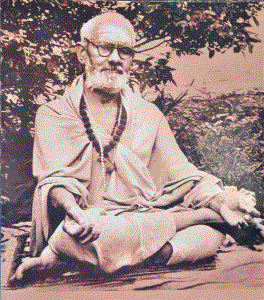
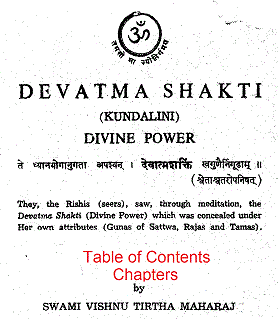

Buy Devatma Shakti on
Amazon
